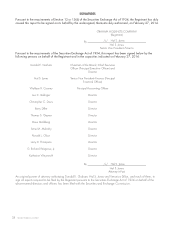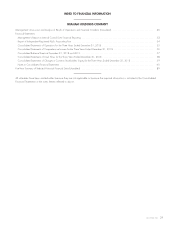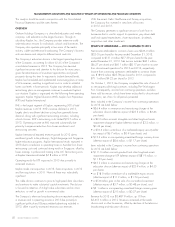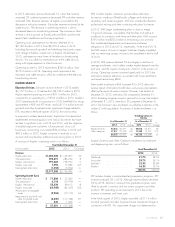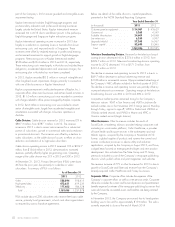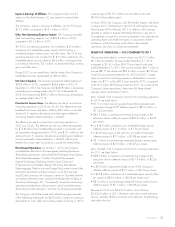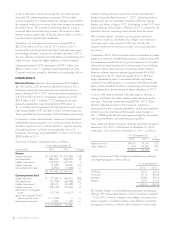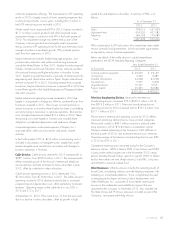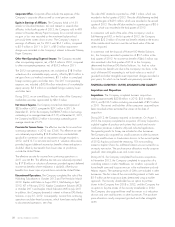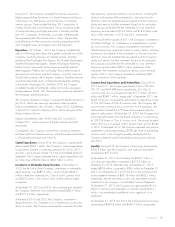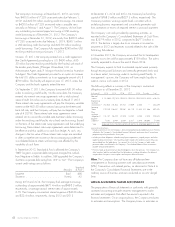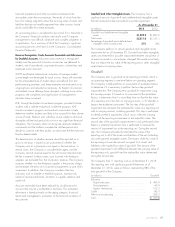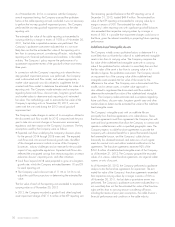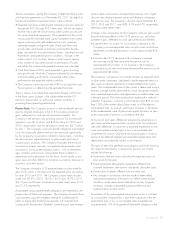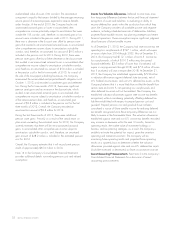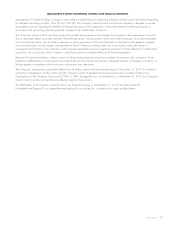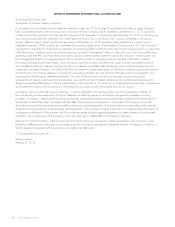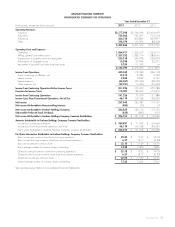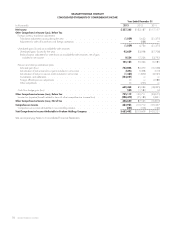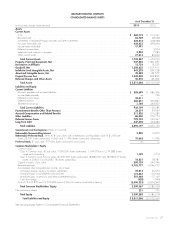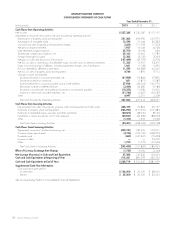Washington Post 2013 Annual Report Download - page 66
Download and view the complete annual report
Please find page 66 of the 2013 Washington Post annual report below. You can navigate through the pages in the report by either clicking on the pages listed below, or by using the keyword search tool below to find specific information within the annual report.
The Company’s borrowings at December 31, 2013, are mostly
from $400.0 million of 7.25% unsecured notes due February 1,
2019, and AUD 50 million revolving credit borrowings; the interest
on $400.0 million of 7.25% unsecured notes is payable semi-
annually on February 1 and August 1. The Company did not have
any outstanding commercial paper borrowing or USD revolving
credit borrowing as of December 31, 2013. The Company’s
borrowings at December 31, 2012, are mostly from $400.0 million
of 7.25% unsecured notes due February 1, 2019, $240.1 million
in USD revolving credit borrowings and AUD 50 million revolving
credit borrowings. The Company fully repaid the $240 million USD
revolving credit borrowing on January 11, 2013.
On June 17, 2011, the Company entered into a credit agreement
(the Credit Agreement) providing for a U.S. $450 million, AUD
50 million four-year revolving credit facility (the Facility) with each of
the lenders party thereto, JPMorgan Chase Bank, N.A. as
Administrative Agent, and J.P. Morgan Australia Limited as Australian
Sub-Agent. The Credit Agreement provides for an option to increase
the total U.S. dollar commitments up to an aggregate amount of U.S.
$700 million. The Facility will expire on June 17, 2015, unless the
Company and the banks agree to extend the term.
On September 7, 2011, the Company borrowed AUD 50 million
under its revolving credit facility. On the same date, the Company
entered into interest rate swap agreements with a total notional
value of AUD 50 million and a maturity date of March 7, 2015.
These interest rate swap agreements will pay the Company variable
interest on the AUD 50 million notional amount at the three-month
bank bill rate, and the Company will pay the counterparties a fixed
rate of 4.5275%. These interest rate swap agreements were
entered into to convert the variable rate Australian dollar borrowing
under the revolving credit facility into a fixed rate borrowing. Based
on the terms of the interest rate swap agreements and the underlying
borrowing, these interest rate swap agreements were determined to
be effective and thus qualify as a cash flow hedge. As such, any
changes in the fair value of these interest rate swaps are recorded
in other comprehensive income on the accompanying condensed
consolidated balance sheets until earnings are affected by the
variability of cash flows.
In September 2013, Standard & Poor’s affirmed the Company’s
“BBB” long-term corporate debt rating and changed the outlook
from Negative to Stable. In addition, S&P upgraded the Company’s
short-term corporate debt rating from “A-3” to “A-2.” The Company’s
current credit ratings are as follows:
Moody’s Standard
& Poor’s
Long-term ........................... Baa1 BBB
Short-term ........................... Prime-2 A-2
During 2013 and 2012, the Company had average borrowings
outstanding of approximately $471.4 million and $483.3 million,
respectively, at average annual interest rates of approximately
6.7%. The Company incurred net interest expense of $33.8 million
and $32.6 million, respectively, during 2013 and 2012.
At December 31, 2013 and 2012, the Company had working
capital of $768.3 million and $327.5 million, respectively. The
Company maintains working capital levels consistent with its
underlying business requirements and consistently generates cash
from operations in excess of required interest or principal payments.
The Company’s net cash provided by operating activities, as
reported in the Company’s Consolidated Statements of Cash Flows,
was $327.9 million in 2013, compared to $477.2 million in
2012. The decline is largely due to an increase in income tax
payments in 2013 and expenses incurred related to the sale of the
Publishing Subsidiaries.
In November 2013, the Company announced that its headquarters
building was to be sold for approximately $159 million. The sale is
currently expected to close at the end of March 2014.
The Company expects to fund its estimated capital needs primarily
through existing cash balances and internally generated funds and,
to a lesser extent, borrowings under its revolving credit facility. In
management’s opinion, the Company will have ample liquidity to
meet its various cash needs in 2014.
The following reflects a summary of the Company’s contractual
obligations as of December 31, 2013:
(in thousands) 2014 2015 2016 2017 2018 Thereafter Total
Debt and
interest .... $ 35,168$ 79,750$ 29,000$ 29,000$ 29,000$414,500 $ 616,418
Programming
purchase
commitments (1) 180,825 108,804 90,723 15,969 5,888 — 402,209
Operating
leases ..... 119,129 106,041 99,167 88,119 73,520 411,466 897,442
Other
purchase
obligations (2) 118,187 56,704 32,505 10,392 4,050 4,005 225,843
Long-term
liabilities (3) 7,052 6,484 6,284 6,107 5,848 39,693 71,468
Total ..... $460,361 $357,783 $257,679 $149,587 $118,306 $869,664 $2,213,380
(1) Includes commitments for the Company’s television broadcasting and cable businesses that are
reflected in the Company’s Consolidated Financial Statements and commitments to purchase
programming to be produced in future years.
(2) Includes purchase obligations related to employment agreements, capital projects and other
legally binding commitments. Other purchase orders made in the ordinary course of business
are excluded from the table above. Any amounts for which the Company is liable under
purchase orders are reflected in the Company’s Consolidated Balance Sheets as accounts
payable and accrued liabilities.
(3) Primarily made up of postretirement benefit obligations other than pensions. The Company has
other long-term liabilities excluded from the table above, including obligations for deferred
compensation, long-term incentive plans and long-term deferred revenue.
Other. The Company does not have any off-balance-sheet
arrangements or financing activities with special-purpose entities
(SPEs). Transactions with related parties, as discussed in Note 4 to
the Company’s Consolidated Financial Statements, are in the
ordinary course of business and are conducted on an arm’s-length
basis.
CRITICAL ACCOUNTING POLICIES AND ESTIMATES
The preparation of financial statements in conformity with generally
accepted accounting principles requires management to make
estimates and judgments that affect the amounts reported in the
financial statements. On an ongoing basis, the Company evaluates
its estimates and assumptions. The Company bases its estimates on
48 GRAHAM HOLDINGS COMPANY


